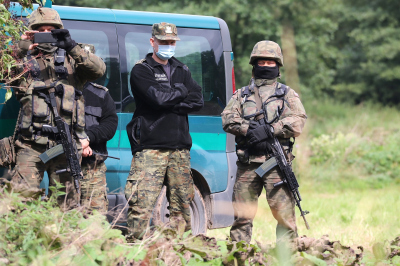
Somali citizen H. crossed the Polish-Belarusian border at the beginning of May 2023. When submitting her application for international protection in Poland, H. declared that she was a minor and presented her Somali birth certificate as proof. The document confirmed that she was 16 years old at the time of crossing the border. As she did not have a passport, the foreign national was subjected to an age test, the result of which categorised her as an adult. At the request of the Border Guard, the Bielsk-Podlaski District Court decided to place the Somali in a guarded centre for foreigners for a period of 30 days. Her detention was later extended by a further 90 days.
After the HFHR was informed that a minor could be held in a guarded centre, the Foundation decided to intervene in the case. Ewa Ostaszewska-Żuk, a lawyer cooperating with the HFHR, appealed against the court's decision, pointing out, among other things, that the law stipulates that the age test must contain information about the error, while H.’s test did not contain such information. Ms Ostaszewska-Żuk argued that the court of first instance had violated the Convention on the Rights of the Child and the European Convention on Human Rights because there were reasonable doubts about the detainee's age, which had not been properly taken into account by the court. As a result, the migrant was wrongly recognised as an adult in the court's decision and the negative effects of detention on her psycho-physical development were not taken into account.
H.'s case is part of a broader problem that the HFHR has recognised for many years. The law, which obliges the authorities to assess the age of a migrant, does not specify how such an assessment should be carried out. The basic method used by the Polish authorities is to x-ray a migrant's wrist and assess the degree of bone development using an anatomical atlas. This method is considered outdated by many doctors and is not able to correctly determine the person's age. Medical professionals claim that this method has a significant margin of error and is based on reference materials that do not take into account ethnicity, nutritional status and diseases, which is particularly relevant for people from conflict zones or areas with limited resources. In 2018, the European Society of Paediatric Radiology issued a recommendation advising against the use of this method.
Following the appeal lodged by the HFHR, the Lublin Regional Court ruled that there were doubts about H.'s age, which should be decided in her favour and she should be considered a minor. The court agreed with H.'s lawyer that the medical assessment, on the basis of which H. was considered an adult, did not allow for a clear determination of the age of the person examined, as it did not contain information on the permissible margin of error.
The court's decision is in line with the case law of international courts, which have repeatedly recognised that procedures for determining the age of a foreigner can lead to a violation of the fundamental rights of migrants. In 2020, the Committee on the Rights of the Child investigated 14 cases related to the age determination of migrants arriving in Spain. In his decisions, the Committee pointed out numerous violations of the Convention on the Rights of the Child by the Spanish authorities, particularly in relation to the right to preserve one's identity, the right to freedom of expression and the right to special protection. The Committee considered that Spain does not adequately assess the age of foreigners when applying the wrist X-ray method, as this test has a margin of error of 4 years, which in principle completely excludes its reliability. The Committee also emphasised that if a person has documents to prove their identity, these should first confirm the person's age, unless there is evidence to the contrary.
In this context, the recent judgment of the European Court of Human Rights in the case of Darbou and Camara v. Italy is also relevant. The case concerns a Guinean citizen who arrived in Italy by sea. Despite the fact that the foreigner claimed to be 17 years old, he was placed in an adult centre and after a month his wrist was x-rayed. According to the ECtHR, the Italian authorities violated the principle of the presumption of minors, which is crucial for protecting the rights of minors. The Court also found that the placement of a minor in an adult centre impaired his right to personal development and relationships. As a result, Italy was found responsible for a violation of Articles 3, 8 and 13 of the European Convention on Human Rights, namely the prohibition of torture, the right to respect for private and family life and the right to an effective remedy. According to the Court, the violation could have been avoided if the minor had been placed in foster care or a facility for minors for the duration of the ongoing proceedings, which would have been in the best interests of the child. Importantly, the Court emphasised that the fact that an increased number of asylum seekers arrive in a Member State does not constitute an excuse for a State to violate the fundamental rights of migrants.
The H. case clearly shows that there is also a systemic problem in Poland related to the use of incorrect methods of assessing the age of foreigners by the authorities. Wrist x-rays are considered an outdated and unreliable method with a large margin of error. At the same time, treating a child as an adult can lead to a number of serious violations related to an incorrect procedure, failure to appoint a guardian and placement in an inappropriate setting, i.e. in a guarded centre instead of foster care.


